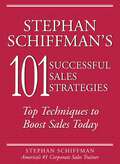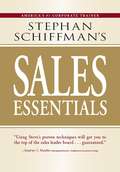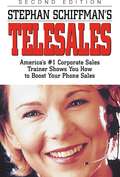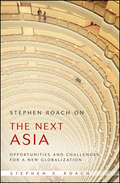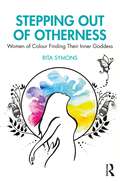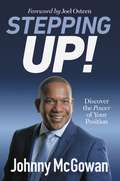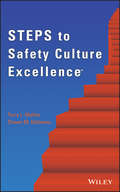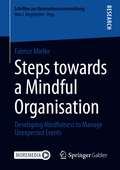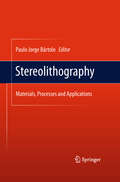- Table View
- List View
Stephan Schiffman's 101 SUCCESSFUL SALES STRATEGIES
by Stephan SchiffmanChock-full of expert insider advice to put you at the top of the sales game, Stephan Schiffman's 101 Most Successful Sales Strategies shows you how to beat out your competition and become number one in the field-starting now!
Stephan Schiffman's 101 Successful Sales Strategies
by Stephan SchiffmanWith sales guru Stephan Schiffman at your side, you can fine tune your sales strategies, and get results immediately! Stephan Schiffman's 101 Most Successful Sales Strategies includes crucial advice on: Building leadership skills; Using E-mail to your advantage; Getting return phone calls; Following the nine principles of cold calling. Chock-full of expert insider advice to put you at the top of the sales game, Stephan Schiffman's 101 Most Successful Sales Strategies shows you how to beat out your competition and become number one in the field-starting now!
Stephan Schiffman's 101 Successful Sales Strategies: Top Techniques to Boost Sales Today
by Stephan SchiffmanBelieve in the power of miracles..."A special little book, an antidote to the stress, fury, and unfeelingness of many people's hurried, everyday lives." --Newsday"Judith Leventhal and Yitta Halberstam amaze and inspire with their incredible-but-true story collections...of wondrous true coincidences." --People"Small Miracles is a book you'll love and cherish for a long time to come. It will make you aware of similar events that are happening to you--those touches of grace that, when we think to look for them, bless us all." --Belle
Stephan Schiffman's Sales Essentials
by Stephan SchiffmanHaving trouble closing your deals? Hitting a frustrating plateau with your sales numbers? Feel that upselling is a lost cause? Let sales guru Stephan Schiffman drive your sales pitches up a notch with his tried-and-true techniques - and get results immediately! Stephan Schiffman's Sales Essentials includes time-tested tips on: Mastering the cold call Using email as a selling tool Raising the stakes to "up" your next buy Closing the deal - every time! Plus, you'll also find 50 surefire questions to ask to make deal after deal, year after year. Packed with insider information you need to beat the competition, you can't afford not to read Stephan Schiffman's Sales Essentials!
Stephan Schiffman's Sales Essentials: All You Need to Know to Be a Successful Salesperson-From Cold Calling and Prospecting with E-Mail to Increasing the Buy and Closing
by Stephan SchiffmanHaving trouble closing your deals? Hitting a frustrating plateau with your sales numbers? Feel that upselling is a lost cause? Let sales guru Stephan Schiffman drive your sales pitches up a notch with his tried-and-true techniques - and get results immediately!Stephan Schiffman's Sales Essentials includes time-tested tips on:Mastering the cold callUsing email as a selling toolRaising the stakes to "up" your next buyClosing the deal - every time! Plus, you'll also find 50 surefire questions to ask to make deal after deal, year after year. Packed with insider information you need to beat the competition, you can't afford not to read Stephan Schiffman's Sales Essentials!
Stephan Schiffman's Telesales
by Stephan SchiffmanIf you've got ten minutes a day, you can make a telesales breakthrough!By providing one concise, easy-to-read chapter for each daily coffee break, Stephan Schiffman's Telesales, Second Edition has the power to transform your career and help you post noticeable increases in your numbers in just ten working days and transform your career after a mere twenty-one. Stephan Schiffman has coached thousands of sales teams across the country to improve their telesales performance.He knows exactly what works and doesn't, and in this completely revised second edition, he shares with you all of his insider's secrets, including how to:Master the five ways you can increase your incomeTrack your numbers . . . and use them to your advantageEvaluate your performance effectively . . . so you hit your own goalsGain control of the callLeave effective phone messagesUse "how" and "why" questions to your advantageLearn what's going on in the prospect's worldUnderstand the four types of negative responses . . . and find out how to get past each oneTurn small adjustments in your performance into large income gainsBy spending just minutes a day with this one clear, concise book, you can learn everything from creating a script; to recognizing when not calling a prospect can increase your sales productivity, to practicing the ten traits of world class salespeople. In this highly competitive world where the obstacles against telemarketers continue to become increasingly daunting, you can't afford not to have these tools in your sales arsenal!
Stephan Schiffman's Telesales: America's #1 Corporate Sales Trainer Shows You How to Boost Your Phone Sales
by Stephan SchiffmanIf you’ve got ten minutes a day, you can make a telesales breakthrough!By providing one concise, easy-to-read chapter for each daily coffee break, Stephan Schiffman’s Telesales, Second Edition has the power to transform your career and help you post noticeable increases in your numbers in just ten working days and transform your career after a mere twenty-one. Stephan Schiffman has coached thousands of sales teams across the country to improve their telesales performance.He knows exactly what works and doesn’t, and in this completely revised second edition, he shares with you all of his insider’s secrets, including how to:Master the five ways you can increase your incomeTrack your numbers . . . and use them to your advantageEvaluate your performance effectively . . . so you hit your own goalsGain control of the callLeave effective phone messagesUse "how" and "why" questions to your advantageLearn what’s going on in the prospect’s worldUnderstand the four types of negative responses . . . and find out how to get past each oneTurn small adjustments in your performance into large income gainsBy spending just minutes a day with this one clear, concise book, you can learn everything from creating a script; to recognizing when not calling a prospect can increase your sales productivity, to practicing the ten traits of world class salespeople. In this highly competitive world where the obstacles against telemarketers continue to become increasingly daunting, you can’t afford not to have these tools in your sales arsenal!
Stephen Richards: Addressing FAQ
by Eugene SoltesStephen Richards, former global head of sales at Computer Associates, addresses frequently asked questions from "A Letter from Prison."
Stephen Roach on the Next Asia
by Stephen RoachAs Morgan Stanley's chief Asia specialist, getting Asia right is Stephen Roach's personal obsession, and this in-depth compilation represents more than 70 of Roach's key research efforts not just on Asia, but also on how the region fits into the broad context of increasingly globalized financial markets. The book argues that the "Asia factor" is not a static concept, but rather one that is constantly changing and evolving. Broken down into five parts-Asia's critical role in globalization; the coming rebalancing of the Chinese economy; a new pan-regional framework for integration and competition; and a frank discussion of the biggest risk to this remarkable transformation-this book will help readers understand and profit from the world's most dynamic region.
Stepping Out of Otherness: Women of Colour Finding Their Inner Goddess
by Rita SymonsWhat might the impact be on a grown woman of having a nursery school teacher change and anglicise her name at the age of three? That three-year-old was me. In our world, we face more and more polarisation and so it feels imperative that we understand the concept and lived experience of “Othering”. Othering takes away individuality and reduces whole groups to “they”.This book explores the theory, examining why Othering is so much part of human biology and conditioning. Through a narrative approach, the experiences of women of colour growing up in 1970s and 1980s Britain are explored, sharing individual stories and common themes. Ultimately this book is a celebration of their deep commitment to self-work and development and their success in navigating the additional burden of being different.We hear from other thinkers and activists, and offer active hope and potential ways forward in how we might create more inclusive, sustainable societies. This is a monumental task but arguably we have no choice, and so the work of changing how we choose to live feels like the most important work we can do together.
Stepping Up
by Timothy D. DobbinsStepping Up explains an elegantly simple yet entirely practical approach to making positive choices at work and in life. Timothy Dobbins, a leading executive coach, a Fellow at the Warton School at the University of Pennsylvania, and a former Episcopal priest, advocates stepping up, or taking responsibility, even if it means having a difficult conversation with a colleague or experiencing the discomfort of making tough decisions, especially at work. Dobbins' approach to the workplace is based on his experiences over the past 16 years helping senior executives and CEOs make the decisions that have made their own companies more humane and more profitable.
Stepping Up!: Discover the Power of Your Position
by Joel Osteen Johnny McGowanUnlock God's power to elevate your position and reach your full potential with Stepping Up! by Lakewood Church pastor Johnny McGowan.No matter your current position, God will unlock the power for you to reach your incredible potential. The key is to approach all you do with a servant's heart versus your own ambition. This guide to serving with passion, integrity, and intuition for success explores how to appreciate today while anticipating the possibilities that await tomorrow.With biblical wisdom and personal insights, Johnny McGowan reveals his own exciting trajectory and the doors that were opened each time he stepped up to serve God. For the past thirty years, he has devoted his gifts to serving Lakewood, one of America's largest churches. Along the way, he has marveled at the leadership opportunities God presented as he stayed committed to serving something larger than himself. By seeking only to fulfill God's will for his life, Johnny has been blessed with increasing responsibility and innumerable ways to make a difference through Stepping Up! Regardless of where you are, God can take you where you want to go-and beyond! Chasing the "number one" role or promotion by your own hands will never be fulfilling. God has even bigger things in store for you, and your future starts now. Learn to listen to God's call and let Him direct your actions. As you do, you'll rise by discovering the true power of your position.
Stepping Up, Second Edition: How Taking Responsibility Changes Everything
by John B. Izzo , Ph.D."The perfect book for the times in which we live . . . page after page of engaging stories, profound insights, and practical tips on how you can stand up and take responsibility for making something meaningful happen." —Jim Kouzes, coauthor of the bestselling The Leadership Challenge All too often, the challenges we face seem overwhelming. Where do we start? What if we fail? But bestselling author John Izzo argues that almost every problem, from personal difficulties and business challenges to social issues, can be solved if all of us look to ourselves to create change rather than looking to others. And with the research to prove it, Izzo shows that by seeing ourselves as the locus of control rather than the victims of change, we are happier, less stressed, and more powerful.Izzo shows how taking responsibility changes our careers, our companies, our lives, and our communities. This book is filled with stories that illustrate the incredible power of stepping up: a homeless man who started a recycling revolution, a middle-aged Italian shopkeeper who fought back against the Mafia, two teenagers who ignited an antibullying movement, an executive who turned a dying division into a profit center, and a few employees who created a multibillion dollar product for Starbucks, and many more. This second edition includes a new chapter on the Stepping Up Continuum, a model that looks at six ways to know if you are stepping up or stepping back, as well as fresh stories and a self-assessment tool for helping leaders create a culture for stepping up in their organizations. We have the power within ourselves to move mountains—we just have to decide that we are the ones to do it.
Stepping into a Universe of Possibility: Shedding Survival-Thinking and Entering a World with Endless Opportunities
by Rosamund Stone Zander Benjamin ZanderOur standard world is one governed by measurement. In this world, each of us strives for success, hoping to arrive at a better place than where we are. But the manifestations of the world of measurement--the winning and losing, the gaining of acceptance and the threat of rejection, the raised hopes and dashed dreams--are all based on the hidden assumption that life is about surviving in a world of scarcity and peril. Even when life is at its best in this world, this assumption keeps the world of possibility obscured. The challenge is learning to see this hidden framework in operation and to believe that there is a universe of possibility that stretches beyond the world of measurement. This chapter describes how to step into this universe of boundless opportunity and imagination. This chapter was originally published as Chapter 2 of "The Art of Possibility: Transforming Professional and Personal Life."
Steps to Safety Culture Excellence
by Terry L. Mathis Shawn M. GallowayProvides a clear road map to instilling a culture of safety excellence in any organizationDid you know that accidental injury is among the top ten leading causes of death in every age group? With this book as your guide, you'll learn how to help your organization develop, implement, and sustain Safety Culture Excellence, vital for the protection of and improvement in the quality of life for everyone who works there.STEPS to Safety Culture Excellence is based on the authors' firsthand experience working with international organizations in every major industry that have successfully developed and implemented ongoing cultures of safety excellence. Whether your organization is a small regional firm or a large multinational corporation, you'll find that the STEPS process enables you to instill Safety Culture Excellence within your organization.STEPS (Strategic Targets for Excellent Performance in Safety) demystifies the process of developing Safety Culture Excellence by breaking it down into small logical, internally led tasks. You'll be guided through a sequence of STEPS that makes it possible to:Create a culture of excellence that is reinforced and empowered at every levelDevelop the capability within the culture to identify, prioritize, and solve safety problems and challengesMaintain and continuously improve the performance of your organization's safety cultureAlthough this book is dedicated to safety, the tested and proven STEPS process can be used to promote excellence in any aspect of organizational performance.By optimizing the safety culture in your organization, you will give the people you work with the skills and knowledge to not only minimize the risk of an on-the-job accident, but also to lead safe, healthy lives outside of work.
Steps towards a Mindful Organisation: Developing Mindfulness to Manage Unexpected Events (Schriften zur Unternehmensentwicklung)
by Fabrice MielkeThis book presents a guideline for turning any organisation into a more mindful one, allowing it to manage unexpected events and develop stronger resilience. The author conducted empirical research with a German IT company’s staff and its leadership in a longitudinal way. The whole team was trained in individual mindfulness competencies. Individual mindfulness is a state of being that can be developed through mindfulness mediation. When combined with social interactions, cultural adaptations and structural changes, collective mindfulness develops. Collective mindfulness allows an organisation to become more agile. The author argues that mindfulness training influences the openness and knowledge-sharing behaviour of an organisation, first on an individual and then a collective level. Such training can generate awareness, increase empathy between the team members, and lead towards a more successful organisation. This study can inspire team managers to improve the work environment as well as academics to update their current level of research in the field of individual and collective mindfulness.
Stereolithography
by Paulo Jorge BártoloStereolithography: Materials, Processes and Applications will focus on recent advances in stereolithography covering aspects related to the most recent advances in the field, in terms of fabrication processes (two-photon polymerization, micro-stereolithography, infrared stereolithography and stereo-thermal-lithography), materials (novel resins, hydrogels for medical applications and highly reinforced resins with ceramics and metals), computer simulation and applications.
Sterile Product Development
by Parag Kolhe Mrinal Shah Nitin RathoreThis comprehensive book encompasses various facets of sterile product development. Key concepts relevant to the successful development of sterile products are illustrated through case studies and are covered under three sections in this book: * Formulation approaches that discuss a variety of dosage forms including protein therapeutics, lipid-based controlled delivery systems, PEGylated biotherapeutics, nasal dosage form, and vaccines * Process, container closure and delivery considerations including freeze-thaw process challenges, best practices for technology transfer to enable commercial product development, innovations and advancement in aseptic fill-finish operations, approaches to manufacturing lyophilized parenteral products, pen / auto-injector delivery devices, and associated container closure integrity testing hurdles for sterile product closures * Regulatory and quality aspects in the areas of particulate matter and appearance evaluation, sterile filtration, admixture compatibility considerations, sterilization process considerations, microbial contamination investigations and validation of rapid microbiological methods, and dry and moist heat sterilizers This book is a useful resource to scientists and researchers in both industry and academia, and it gives process and product development engineers insight into current industry practices and evolving regulatory expectations for sterile product development.
Sterling Household Products Company
by William E. Fruhan Craig StephensonSterling Household Products manufactures and markets a broad line of consumer goods from laundry soap and cosmetics to cleaning, disinfecting, and sanitizing products. The company has many highly regarded brand names and consistently reports impressive sales and profits to the investment community. Despite a record of success, a deeper analysis of financial measures reveals that growth rates for unit volumes, sales, and profits are low. Looking to expand into new markets with strong growth potential, the company considers acquiring the germicidal, sanitation, and antiseptic product unit from Montagne Medical Instruments, a company in the health care industry. This acquisition seems like a natural extension of Sterling's experience and expertise in the market for household cleaning supplies. Both parties reach a tentative agreement on price and Sterling considers whether the proposed investment adds value given the risks involved. Students must perform a comprehensive investment analysis and examine both the qualitative and quantitative issues associated with evaluating a strategic acquisition before making a final recommendation.
Stermon Mills, Inc.
by David M. UptonA paper company is unable to compete on cost as a result of the installation of three very efficient paper machines by competitors. Prices for its products are falling by the day, and the company is making a loss. In the face of such competition, management feels that the only course of action is to improve "flexibility" and/or take advantage of the flexibility they already have. The problem is that no one knows quite what flexibility is, let alone how to implement an improvement plan. The case describes four improvement paths, each of which might be considered to improve "flexibility." The conflicts between these plans are also considered by the company. In addition, the sales force gives a look at the flexibility requirements of the company from the customer's viewpoint.
Steuergerechtigkeit: Die Besteuerungsprinzipien eines verfassungskonformen Steuerrechts
by Reiner SahmDieses Buch vermittelt die ethischen Grundprinzipien eines gerechten, verfassungskonformen Steuerrechts und die wesentlichen Reformvorschläge und -perspektiven des 20. und 21. Jahrhunderts für ein transparentes und effizientes Steuersystem in Deutschland. Bereits vor über 100 Jahren initiierte der Reichsfinanzminister Matthias Erzberger eine umfassende Reform der Finanzverfassung und des Steuersystems, um „Gerechtigkeit im gesamten Steuerwesen zu schaffen“. Doch die Systematik dieser ehemals international hoch angesehenen deutschen Steuergesetze hat in der Geschichte der Bundesrepublik Deutschland kontinuierlich gelitten, da der Gesetzgeber fortlaufend einer Vielzahl politischer Erwägungen den Vorrang einräumte. Aktuell stellen Steuerrechtswissenschaftler jedoch die Steuergerechtigkeit auf Basis konsistenter Prinzipien in den Mittelpunkt ihrer Überlegungen, um den Inhalt und die Grenzen der staatlichen Rechte zu bestimmen. Die in diesem Buch dargestellten ethisch fundierten Rechtsprinzipien bilden daher eine gute Grundlage, um ein neues Steuersystem für Deutschland zu gestalten, das einfacher, sozialer, transparenter und gerechter ist.
Steuergerechtigkeit: Für ein prinzipientreues und rechtsstaatliches Steuerrecht
by Reiner SahmDieses Buch vermittelt die ethischen Grundprinzipien eines gerechten, verfassungskonformen Steuerrechts und die wesentlichen Reformvorschläge und -perspektiven des 20. und 21. Jahrhunderts für ein transparentes und effizientes Steuersystem in Deutschland. Die überarbeitete und erweiterte zweite Auflage wurde aktualisiert und um das Thema ergänzt. Bereits vor über 100 Jahren initiierte der Reichsfinanzminister Matthias Erzberger eine umfassende Reform der Finanzverfassung und des Steuersystems, um „Gerechtigkeit im gesamten Steuerwesen zu schaffen“. Doch die Systematik dieser ehemals international hoch angesehenen deutschen Steuergesetze hat in der Geschichte der Bundesrepublik Deutschland kontinuierlich gelitten, da der Gesetzgeber fortlaufend einer Vielzahl politischer Erwägungen den Vorrang einräumte. Aktuell stellen Steuerrechtswissenschaftler jedoch die Steuergerechtigkeit auf Basis konsistenter Prinzipien in den Mittelpunkt ihrer Überlegungen, um den Inhalt und die Grenzen der staatlichen Rechte zu bestimmen. Die in diesem Buch dargestellten ethisch fundierten Rechtsprinzipien bilden daher eine gute Grundlage, um ein neues Steuersystem für Deutschland zu gestalten, das einfacher, sozialer, transparenter und gerechter ist.
Steuergerechtigkeit: Für ein prinzipientreues und rechtsstaatliches Steuerrecht
by Reiner SahmDieses Buch vermittelt die ethischen Grundprinzipien eines gerechten, verfassungskonformen Steuerrechts und die wesentlichen Reformvorschläge des 20. und 21. Jahrhunderts für ein transparentes und effizientes Steuersystem in Deutschland. Die aktuelle dritte Auflage wurde leicht verbessert, insbesondere wurden neue Stellungnahmen der Expertenkommissionen des BMF zu Reformthemen aufgenommen. Bereits vor über 100 Jahren initiierte der Reichsfinanzminister Matthias Erzberger eine umfassende Reform der Finanzverfassung und des Steuersystems, um „Gerechtigkeit im gesamten Steuerwesen zu schaffen&“. Doch die Systematik der ehemals international hoch angesehenen deutschen Steuergesetze hat in der Geschichte kontinuierlich gelitten, da der Gesetzgeber fortlaufend einer Vielzahl politischer Erwägungen den Vorrang einräumte. Aktuell fokussieren Steuerrechtswissenschaftler die Steuergerechtigkeit auf Basis konsistenter Prinzipien in ihren Überlegungen, um Inhalt und Grenzen der staatlichen Rechte zu bestimmen. Die hier dargestellten ethisch fundierten Rechtsprinzipien bilden eine gute Grundlage für ein neues Steuersystem in Deutschland, das einfacher, sozialer, transparenter und gerechter ist.
Steuerhinterziehung in der Schweiz: Mehr als nur kriminelle Energie: Hintergründe - Erklärungsversuche - Ansätze zur Bekämpfung
by Roland HofmannSteuerehrlichkeit ist für viele Steuerpflichtige eine Gratwanderung zwischen Aufrichtigkeit und empfundener Ungerechtigkeit, mithin ein soziales Dilemma. Auch die Rolle der Banken und des Bankkundengeheimnisses hinsichtlich der Steuerehrlichkeit hat sich in den letzten Jahren fundamental verändert. Roland Hofmann erläutert das Phänomen der Steuerhinterziehung aus finanzwissenschaftlicher Perspektive und macht deutlich, dass verschiedene Beweggründe dazu führen und nicht immer ausschliesslich kriminelle Energie dahintersteckt. Oft ist unklar, ob Aufdeckung und Bestrafung die richtigen Mittel sind, um Steuerhinterziehung wirksam zu bekämpfen. Dieses Buch erörtert alternative Ansätze und stellt neue Anreize zur Steuerehrlichkeit vor.
